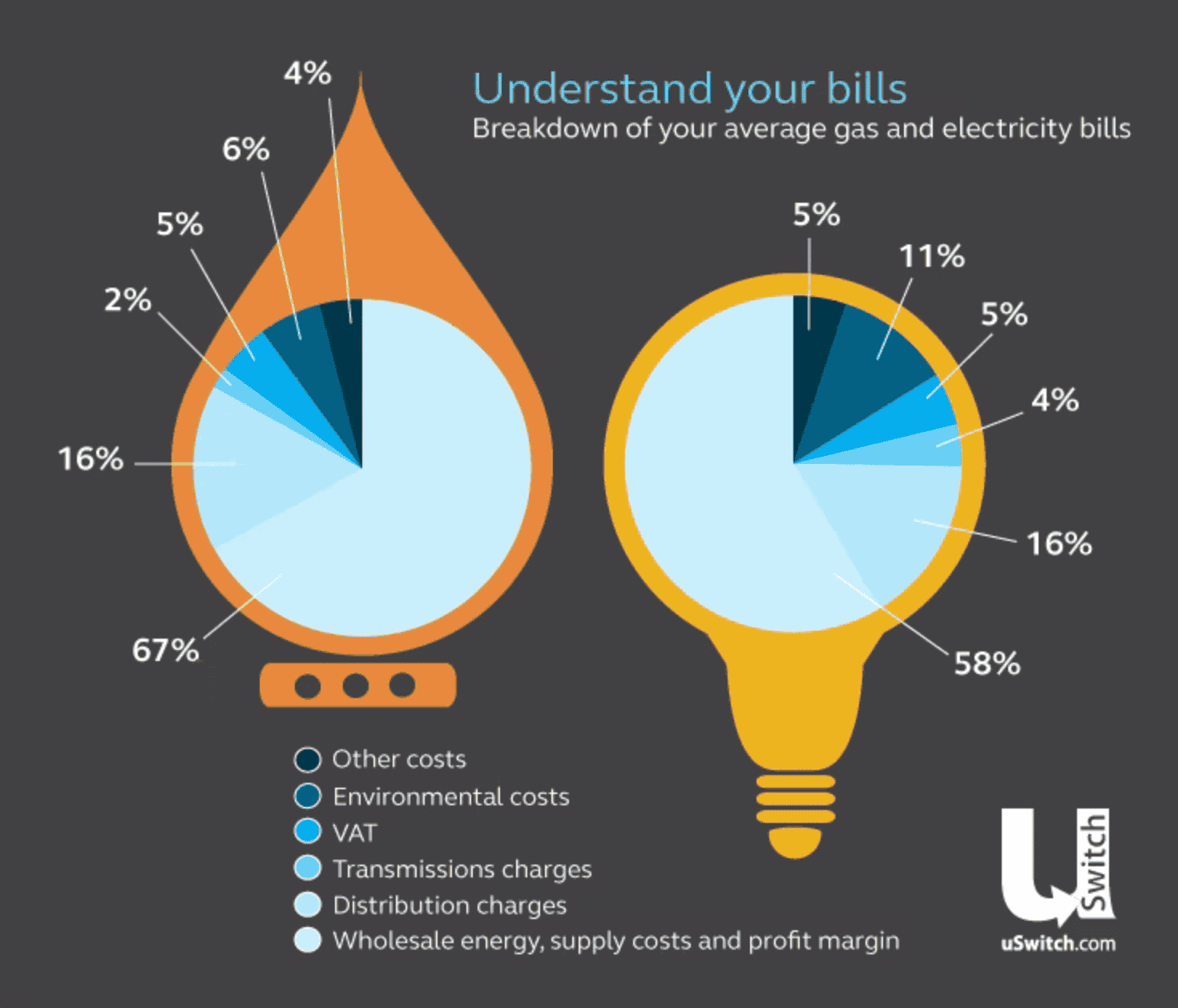- Uswitch.com>
- Gas and Electricity>
- Guides>
- How to understand gas and electricity utility bills - Uswitch
Gas and electricity utility bills breakdown
The average utility bill is made up of several different components. Here is a breakdown of an average utility bill to give you a better idea of where your money is going.
Supply costs are the costs the energy supplier incurs for the general administration associated with a retail business - for example running a call centre and sending out bills - and these vary according to what tariff you are on.
Breakdown of your average utility bill
Environmental costs
A proportion of your gas and electricity bill is used to subsidise the government's environmental initiatives. Environmental schemes which are subsidised by your gas and electricity bill include:
Feed-in Tariff scheme (FITs)
Carbon Emissions Reduction Target (CERT)
Community Energy Saving Programme (CESP)
The Renewables Obligation (RO)
EU Emissions Trading Scheme (ETS).
VAT charges
Contrary to popular belief, you do not pay full VAT on gas and electricity, but you do pay some.
Transmission charges
Transmission networks are what actually deliver electricity and gas to your home, and some of the cost of building and maintaining transmission chargers is passed on to customers.
Distribution charges
Distribution costs relate to the cost of building, maintaining and operating the local gas pipes and electricity wires which deliver energy to the home.
Wholesale energy and supply costs
The bulk of your bill, unsurprisingly, is comprised of the charges you actually pay for the gas and electricity you use. Wholesale cost refers to the price that the energy supplier has to pay for the gas and electricity they buy.
Supply costs are the costs the energy supplier incurs for the general administration associated with a retail business - for example running a call centre and sending out bills - and these vary according to what tariff you are on.
Other costs
Meter installation and gas storage costs comprise small percentages of your energy bill.
How to save money on your energy bill
These energy-saving tips will help you bring your energy bills down as well as reduce your carbon footprint.
Heating
The biggest portion of your energy bill is taken up with heating your home and your water. Follow these tips and you could save a fortune on your heating bills:
Turn your thermostat down by a single degree. This could save you as much as £145 on your energy bills over the space of a year
Make sure your home is adequately insulated. Loft and cavity wall insulation may require an initial investment, but could easily save you hundreds a year in heating costs
If you're on a low income, you may be eligible for an energy efficiency grant to make improvements to your home. Find out if you could be eligible and how to apply
Try to block any draughts that are coming into your house and make sure you close your curtains to keep the heat in.
In the kitchen
The next largest portion goes towards powering our washing machines, fridges, freezers and cooking appliances. Keep these costs down with these tips:
Do your washing less frequently. It may sound obvious - but keep the number of wash loads down by making sure the machine is full every time for maximum efficiency
Use the economy setting on your washing machine. Many washing powders will now work at temperatures as low as 30 degrees, which is enough to effectively wash clothes while also helping your machine run more efficiently
Dry your clothes outside or on a clothes horse. Tumble dryers use a lot of energy, so if you can dry your clothes for free, that will help keep costs down
Replace your current fridge and/or freezer with an energy-efficient model. Look out for the energy efficiency stickers on modern appliances. You should also make sure they're kept as full as possible and that the area around them is kept clean so they don't have to work as hard.
Computers, gadgets and electronics
Next up is the amount of energy used by consumer electronics such as DVDs, TVs and computers every year. Bring this cost down with the following tips:
Don't leave electronics on standby. If you're forgetful, invest in a standby saver - it will automatically cut the power to any electronics left on standby
Don't charge your gadgets unnecessarily. For example, don't leave laptops and mobile phones charging overnight, as this is a big waste of energy
Don't leave your computer and related devices on when you're not using them. Make sure speakers/monitors/printers are turned off when you've finished with them.
Lighting
Finally, there is the portion of our bills going towards lighting our homes. The easiest ways to save on your lighting costs are to:
Buy energy-efficient LED lightbulbs. They last up to 25 times longer than incandescent lightbulbs and each one you swap could save you at least £4 per year
Turn the lights off behind you when you leave a room and get into the habit of switching the lights off as you move through the house.
Read more:

OVO Energy bills explained - Uswitch
Having trouble understanding your OVO bill? Use Uswitch's helpful energy bill breakdown to cut through the confusion.
Learn more
E.ON Next energy bill explained - Uswitch
We break down a sample statement to help you read your E.ON Next energy bill and cut through the confusion.
Learn more

